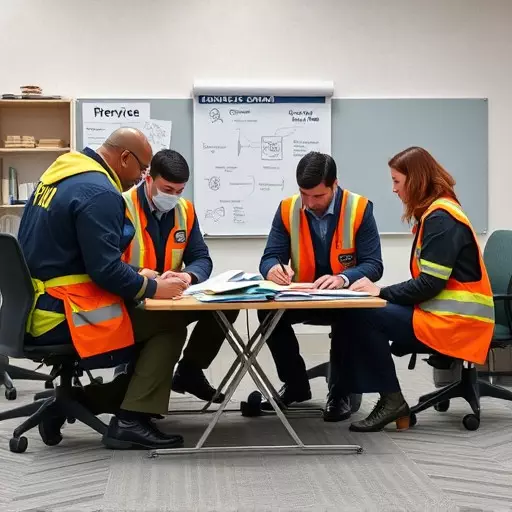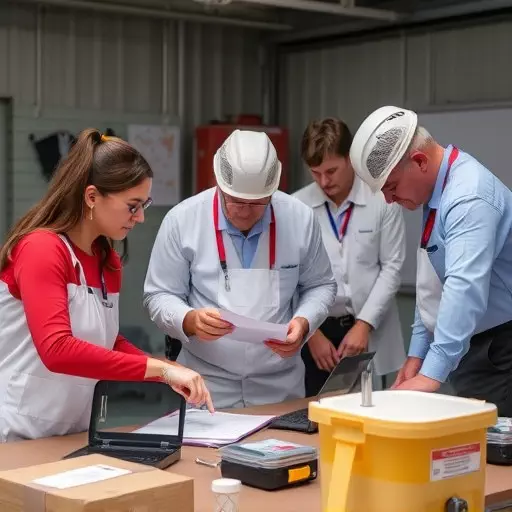TL;DR:
Process Hazard Analysis (PHA) relies on PHA facilitation experts using specialized pha facilitation tools and hazard identification techniques to assess industrial processes. These experts guide teams through structured methodologies, uncovering hidden hazards and their potential consequences via scenario-based analysis, fault tree analysis (FTA), and event tree analysis (ETA). Real-world applications demonstrate improved safety, reduced downtime, and better risk management through this approach. By following a defined scope, utilizing robust tools, engaging stakeholders, and conducting rigorous data analysis, organizations can enhance process safety and mitigate risks effectively.
“Consequence analysis is a cornerstone of Process Hazard Analysis (PHA), crucial for identifying and mitigating risks in industrial processes. This article delves into the essential role of PHA facilitation experts in enhancing hazard detection. We explore powerful facilitation tools that unlock robust consequence analysis capabilities. Furthermore, we present various hazard identification techniques used in process safety assessments and provide real-world case studies showcasing the impact of comprehensive consequence analysis. Best practices for implementation are also discussed to guide professionals in ensuring effective risk management.”
- Understanding Consequence Analysis: A Foundation for PHA Expertise
- The Role of PHA Facilitation Experts in Enhancing Hazard Identification
- Unlocking the Power of PHA Facilitation Tools
- Various Hazard Identification Techniques in Process Safety Assessments
- Case Studies: How Consequence Analysis Impacts Real-World Industrial Projects
- Best Practices for Implementing Comprehensive Consequence Analysis in PHAs
Understanding Consequence Analysis: A Foundation for PHA Expertise
Consequence analysis is a cornerstone in Process Hazard Analysis (PHA), providing a structured framework to identify and assess potential risks associated with industrial processes. This analytical approach allows pha facilitation experts to delve into the intricate web of events that could occur during a process, from initial hazard identification techniques to the eventual impact on people, assets, and the environment.
As a vital tool in the arsenal of pha facilitation tools, consequence analysis equips professionals with the knowledge to make informed decisions. By thoroughly understanding the potential outcomes of various scenarios, experts can facilitate more effective risk management strategies, ensuring that safety measures are proportionate to identified hazards. This comprehensive process forms the basis for robust PHA expertise, enabling industries to navigate complex operations with confidence and mitigate potential catastrophic events.
The Role of PHA Facilitation Experts in Enhancing Hazard Identification
PHA Facilitation Experts play a pivotal role in enhancing hazard identification within Process Hazard Analysis (PHA). Their expertise lies in guiding teams through structured techniques and proven pha facilitation tools to ensure comprehensive coverage of potential risks. These experts facilitate discussions, encourage critical thinking, and help uncover hidden or overlooked hazards that might be missed by conventional methods.
By leveraging advanced hazard identification techniques, PHA Facilitation Experts ensure that organizations consider a wide range of scenarios and conditions. They foster an environment where all stakeholders actively participate, bringing diverse perspectives to the table. This collaborative approach not only improves the accuracy of hazard identification but also cultivates a culture of safety awareness and continuous improvement within the organization.
Unlocking the Power of PHA Facilitation Tools
PHA facilitation experts leverage specialized tools to unlock the full potential of hazard identification techniques. These tools are designed to streamline and enhance the process, ensuring that no stone is left unturned in identifying potential risks. By employing advanced methodologies, pha facilitation experts can navigate complex systems with ease, uncovering hidden hazards that might otherwise be overlooked.
The effectiveness of these pha facilitation tools lies in their ability to foster a structured yet adaptive approach. They enable teams to efficiently analyze various scenarios, consider multiple facets of a process or system, and make informed decisions. With the right set of tools, organizations can significantly improve their risk management strategies, ultimately leading to safer operations and more robust decision-making processes.
Various Hazard Identification Techniques in Process Safety Assessments
In process safety assessments, various hazard identification techniques are employed by PHA facilitation experts using specialized PHA facilitation tools. These methods play a crucial role in uncovering potential risks associated with industrial processes. One common approach is the use of scenario-based analysis where experts envision and analyze different scenarios to identify hazards. This technique allows for a comprehensive examination of how various factors interact, leading to potential safety issues.
Another effective method is fault tree analysis (FTA), which systematically breaks down a complex system into its constituent components. By identifying potential faults at each level, FTA helps in understanding the root causes of accidents. Additionally, event tree analysis (ETA) complements FTA by expanding on the consequences of initial events, providing a deeper insight into the potential impact and severity of identified hazards. These hazard identification techniques collectively empower PHA facilitation experts to make informed decisions, enhancing process safety and ensuring the effective implementation of risk mitigation strategies.
Case Studies: How Consequence Analysis Impacts Real-World Industrial Projects
Case studies illustrate the tangible impact of consequence analysis in real-world industrial projects guided by PHA facilitation experts. By employing advanced pha facilitation tools, these professionals help organizations uncover potential hazards and their consequences with greater precision. This process involves utilizing robust hazard identification techniques to unravel complex interdependencies within industrial systems.
Through these case studies, it becomes evident that consequence analysis empowers decision-makers to implement targeted risk mitigation strategies. This proactive approach not only enhances overall project safety but also optimizes operational efficiency by identifying and addressing potential bottlenecks early in the planning phase. Consequently, industries benefit from reduced downtime, minimized financial losses, and improved regulatory compliance.
Best Practices for Implementing Comprehensive Consequence Analysis in PHAs
Implementing comprehensive consequence analysis in Process Hazard Analysis (PHA) requires a structured approach and the right tools. pha facilitation experts recommend a systematic process that starts with defining the scope and goals of the analysis, followed by thorough hazard identification techniques. Utilizing specialized pha facilitation tools can significantly enhance this phase, enabling a detailed breakdown of potential hazards and their consequences.
These tools often include checklists, matrixes, and simulation software designed to capture all possible scenarios. Engaging relevant stakeholders throughout the process ensures a holistic view of risks. By combining these best practices with rigorous data analysis and risk assessment methods, organizations can effectively identify vulnerabilities, set appropriate mitigation strategies, and improve overall process safety.


